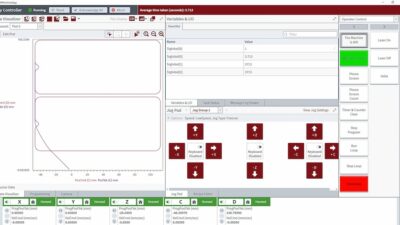In 1999, saddled with an antiquated IT system from a vendor that had gone out of business, Brooklyn-based Lee Spring, a privately held manufacturer of industrial components, issued a request-for-proposal (RFP). The manufacturer was looking for a new system by which it could run its operations. One of the key requirements was the ability to support several sites.
In 1999, saddled with an antiquated IT system from a vendor that had gone out of business, Brooklyn-based Lee Spring , a privately held manufacturer of industrial components, issued a request-for-proposal (RFP). The manufacturer was looking for a new system by which it could run its operations. One of the key requirements was the ability to support several sites.
“It had to function in multiple locations and multiple plants, and handle multiple warehouses. It required visibility to tie it all together on an executive level so that we could actually drill down and see what’s happening, to see the movement, to see what’s going on,” says Mike Gisonda, IT director, Lee Spring.
Lee Spring chose a solution from ERP vendor SYSPRO . Now, says Gisonda, “We have a good feel for what’s going on in our operations and our divisions because we have complete visibility.”
Rene Inzana, SYSPRO product marketing manager, says the solution enables comprehensive visibility by giving global manufacturers the flexibility they are looking for.
“It’s designed so the enterprise functions as a single unit, viewing consolidated information or breaking that information out the way you want,” says Inzana.
Work as one
For manufacturers with distributed operations, the desire for complete visibility and greater IT flexibility is a familiar one. They may be making different products in different plants around the world, but they still want to manage their facilities as part of one comprehensive network.
Symmetry Medical is one such manufacturer trying to more closely integrate its plants. A provider of implants, instruments, and cases for orthopedic device manufacturers and other medical companies, Symmetry has 21 facilities around the world. Until recently, it operated the plants as stand-alone entities.
Symmetry also has grown through acquisition, picking up certain companies with products similar to those made by Symmetry.
“We want to leverage these multiple facilities that are making similar products across one platform,” says Fred Hite, senior VP and CFO of Symmetry Medical.
To do that, Symmetry installed a single instance of Vantage manufacturing software from Epicor Software . Vantage has since helped the company do a better job of distributing production across multiple plants while consolidating inventory and customer information.
“Rather than having one customer in multiple databases and multiple people doing order entry and receivable collections, we are consolidating some of that into multiple facility instances,” Hite explains.
“This ability to spread information around the organization and have it entered only once is a big part of how we help companies that are global in nature,” says Paul Farrell, VP of worldwide research and development for Epicor.
Operations management software vendor Apriso says its FlexNet Global Manufacturing Suite (GMS) enables ERP system access to production data at multiple facilities and locations, connecting those operations for true enterprisewide visibility.
According to Farrell, another way Epicor’s solutions help manufacturers with distributed operations is by allowing them to “virtualize the back end.” This helps when a manufacturer is made up of different entities yet still wants to give its customers or suppliers the illusion they are dealing with one organization.
For example, a manufacturer may comprise three separate entities. To give customers a single point of contact, the manufacturer sets up a fourth entity—a virtual one that only exists in the IT system—through which all sales are processed. So even if a sales order requires parts supplied from the first three entities, the system synchronizes what those entities are doing to meet the end requirements of the customer, while hiding complex back-end transactions from the customer.
This functionality, says Farrell, is made available in the application via service-oriented architecture. “The system doesn’t connect up to one single database and go and grab that information,” he says. “Instead it messages out to the different companies around the world to [place] that information in the background.”
Unique undertakings
Another vendor focused on helping manufacturers manage multiplant environments is Apriso , a provider of operations management solutions for manufacturers. In 2006, Apriso rolled out its FlexNet Global Manufacturing Suite (GMS), which it describes as the first packaged solution for managing multiple manufacturing facilities.
Tom Comstock, Apriso senior VP of product management and marketing, says GMS addresses issues unique to multiplant environments, including defining and managing best practices.
Symmetry Medical, a components maker serving the medical device industry, uses Vantage manufacturing software from Epicor to distribute production across multiple plants.
“You have a couple of challenges with best practices,” says Comstock. “One is to define the best practices, and that’s often where you start with that whole visibility issue. But if you have a best practice, you need to be able to package it up and push it out to the sites that are impacted by that particular process. In FlexNet—our product set—we have what’s called Global Process Manager, which is used to define a process and move it to different locations so it can be implemented in those plants.”
But Comstock still cautions one particular problem surrounding best practices: that of governance. Decisions about governance revolve around how much autonomy a manufacturer is comfortable granting to its plants. It can be a delicate balancing act.
“Do I let the plants change [the practice] when they get it? How much freedom should they have?” Comstock asks.
Comstock believes manufacturing companies are filled with very practical people who want to be able to achieve their goals directly. “They tend to resist the notion of someone from the home office telling them what to do,” he says. “But I have seen a shift in thinking in recent years, with manufacturers starting to understand that achieving their objectives may require a lot more [enterprisewide] collaboration.”
Another production issue involving multiple plants surrounds the use of realistic performance metrics, such as overall equipment effectiveness (OEE). Centrally defining these types of metrics is critical, says Comstock.
“Rather than just seeing a dashboard in a facility that says, ‘My OEE is good,’ now I want to be able to roll it up and compare OEE across plants,” he says. “To do that, you need to apply the same definition of OEE, but everyone wants to define it the way that makes them look the best. If you don’t have that central definition to push down so everyone is calculating it the same, you can’t get a fair rollup.”
Collective controls
Manufacturers also must standardize the way they collect the data that drives the metrics, says Darren Riley, segment business lead for software and applications with Rockwell Automation , a specialist in industrial automation control and information solutions.
“If you collect [data] manually in one plant and automatically in another, right off the bat the timeliness is off,” says Riley. “[The manual approach] takes a lot longer, is error-prone, and obviously may not be in sync with an automatic data collection system you may have in a sister plant.”
And then there are the issues associated with analyzing the data.
“When you start collecting data off the floor and roll it all the way up from machine to line to plant to enterprise, when you get to the enterprise, the analytics are pretty mind-boggling,” Riley says.
Riley says that kind of data flow requires “a much higher level of analytic tools to do the evaluation. So you might be looking at OLAP tools,” he says. “An [enterprise manufacturing intelligence] tool may not be adequate to do that kind of comparison anymore.”
And some types of comparisons might be impossible.
For example, says Riley, if a manufacturer builds to stock one type of product in one plant and builds to order another product in another plant, “How does it even begin to compare the efficiencies of those two plants?” he asks. “In some situations you can’t, because they’re completely different in terms of some of the metrics, but in terms of performance and margin, you certainly can.”
Analyzing production data may be tricky, but it’s an important part of gauging performance. It becomes especially crucial when trying to ensure consistent quality across a network of plants.
“You may have production orders for the same customer, but they are being made in different facilities,” says Keith Jones, a program manager for operations management software provider Wonderware . “You need to be able to record and monitor the quality of production—very often in real time—as different parts of an order are being made, and then coordinate those production orders so you’re delivering them back to the end user at the right time.”
One way manufacturers control quality on multiple lines and in multiple plants is by creating what is known as a golden batch. Often used in the food & beverage industry, golden batches represent a perfect batch of a product that is being made.
Companies can use the golden batch process as a yardstick against which they can model, in real time, the performance of other batches in production. This allows them to instantly see any process deviations that would result in an inferior batch.
The information collected from each production process also can be historized.
“You can build up an average or an aggregate picture of all of the batches that you’re doing and see how you are adhering to quality in your facility as opposed to another facility—or even from one shift to another,” concludes Jones. “Then you can validate and drill down into what may be causing anomalies in quality and production.”
DataMart delivers: Manufacturing intelligence tool synchronizes multiplant environments
Manufacturers rely on data generated by equipment on the plant floor to track operational performance. But the amount of data they must manage and analyze can be overwhelming—particularly when it comes from multiple plants.
That’s why vendors such as GE Fanuc Intelligent Platforms are stepping up to the plate with new tools that facilitate multiplant performance analysis. In September, GE Fanuc released Proficy DataMart, an enterprise application that sits on top of the company’s Proficy Plant Applications suite.
Proficy DataMart takes raw data and aggregates it, speeding metrics retrieval. Users can then access metrics and reports through Proficy Portal, Microsoft Excel, Microsoft SQL Reporting Services, or other OLAP-compliant tools.
“Proficy DataMart is an evolution of what we’ve been doing with Plant Applications,” says Barry Lynch, global product manager for Proficy DataMart—that is, taking raw data from the plant floor, “the bits and bytes, and transforming that into business information for them… converting it into the language of the business,” he says.
In recent years, customers have been pulling those bits and bytes from multiple plants. According to Lynch, at least half of the customers using Proficy Plant Applications have deployed them across multiple sites. And some were developing their own solutions for analyzing the data from various plants.
Proficy DataMart gives manufacturers “an off-the-shelf product that can be installed and connected to one or many of these sites, giving them access to that data to do key performance indicator benchmarking across multiple sites,” says Lynch.
Unlike historians, the product takes raw data and then aggregates it, speeding metrics retrieval. Users can then access metrics and reports through Proficy Portal, Microsoft Excel, Microsoft SQL Reporting Services, or other OLAP-compliant reporting and analysis tools.
Because analyzing data from multiple plants can be considerably more complex than pulling and analyzing data from a single plant floor, Proficy DataMart functions as an enterprise-scale solution. “So the scope has always been, ‘How do I bring 50, 100 plants together; and how do I scale and how do I optimize that?’” Lynch explains.
Lynch says the solutions that manufacturers customize to meet their global manufacturing intelligence needs often have problems with performance.
“They’re great if you want to get a day’s or a week’s worth of data,” concludes Lynch. “But if you want to know how well that machine did for the last five years, and you want to see that in seconds, that’s where these types of systems that we’ve put together are fantastic because they’re designed to be deployed across an enterprise— deployed rather than something that is site-based that someone is trying to scale up to cover additional sites.”



